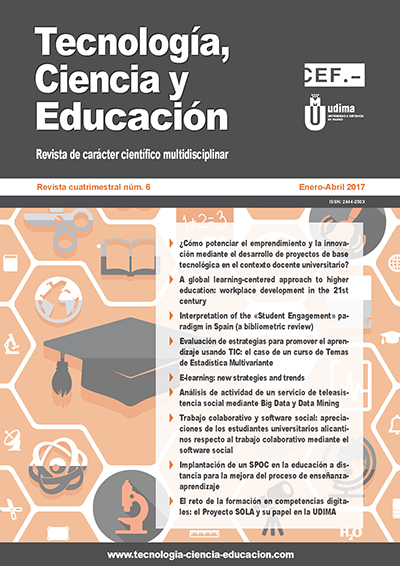Implantación de un SPOC en la educación a distancia para la mejora del proceso de enseñanza-aprendizaje
DOI:
https://doi.org/10.51302/tce.2017.119Palabras clave:
massive open on-line courses (MOOC), small private on-line courses (SPOC), educación superior, metodología, material audiovisualResumen
La introducción de las tecnologías de la información y la comunicación (TIC) ha supuesto un gran cambio en muchos aspectos dentro del ámbito educativo, como, por ejemplo, en la forma de procesar la información y de adquirir el conocimiento por parte de los alumnos, debido a su inmersión dentro de una cultura audiovisual. Esto ha provocado que muchos docentes, con el fin de mejorar el proceso de enseñanza-aprendizaje, hayan introducido el vídeo en sus aulas.
Una de las modalidades formativas que utiliza este tipo de material didáctico (vídeo) como base de su metodología son los massive open on line courses (MOOC). Estos cursos, que son de carácter abierto, masivo y se realizan en plataformas especializadas, han sufrido una gran evolución desde su aparición en 2012, haciendo que de su metodología se deriven diversas modalidades de cursos. Este es el caso de los small private on line courses (SPOC), que mantienen la estructura y la metodología de los MOOC, pero restringiendo el número de alumnos y el acceso a los mismos.
El presente trabajo propone un proyecto basado en la implantación de un SPOC dentro de la educación a distancia on line como «curso cero de matemáticas» para las nuevas incorporaciones en las titulaciones de Ingeniería. La finalidad de este proyecto es comprobar si esta metodología basada en el formato audiovisual mejora de manera significativa el proceso de enseñanza-aprendizaje respecto a la metodología utilizada hasta el momento.
Descargas
Citas
Atmojo, K. y Bandung, Y. [2012]: «Eduvid, web video to support digital learning in rural primary schools», IEEE International Conference on Cloud Computing and Social Networking (ICCCSN), págs. 1-4. Disponible en: http://ieeexplore.ieee.org/xpl/articleDetails.jsp?arnumber=6588114 [Consultado: mayo de 2016].
educaLAB [2016]: ¿Qué es un NOOC? Disponible en: http://educalab.es/intef/formacion/formacion-en-red/nooc [Consultado: junio de 2016].
Fox, A. [2013]: From MOOCs to SPOCs. Disponible en: http://dl.acm.org/citation.cfm?id=2535918 [Consultado: mayo de 2016].
Fox, A.; Patterson, D. A.; Ilson, R.; Joseph, S.; Walcott-Justice, K. y Williams, R. [2014]: Software engineering curriculum technology transfer: lessons learned from MOOCs and SPOCs, Electrical Engineering and Computer Sciences University of California at Berkeley, Technical Report. Disponible en: http://digitalassets.lib.berkeley.edu/techreports/ucb/text/EECS-2014-17.pdf [Consultado: julio de 2016].
Hickey, D. [2014]: Brief history of the BOOC, digital badges, and educational assessment. Disponible en: http://www.indiana.edu/~booc/what-is-a-booc/ [Consultado: enero de 2016].
Jiménez, J. R. [2009]: La importancia del material didáctico en el proceso de enseñanza-aprendizaje. Disponible en: http://www.monografias.com/trabajos76/material-didactico-proceso-ensenanza-aprendizaje/material-didactico-proceso-ensenanza-aprendizaje2.shtml [Consultado: mayo de 2016].
Kozma, R. B. [1991]: «Learning with media Robert B. Kozma University of Michigan», Review of Educational Research, 61 (2), págs. 179-212.
Lancho, M. S. [2014]: «MOOCs y SPOCs (small private online courses): sus posibilidades para la formación del profesorado», Hamut’ay, 1 (1), págs. 6-17. Disponible en: http://200.37.174.118/ojs/index.php/HAMUT/article/view/568/460 [Consultado: junio de 2016].
MacVie, L. [2013]: SPOCS: the doable open courses for medium-sized institutions [blog]. Disponible en: http://leahmacvie.com/2013/12/spocs-are-doable/ [Consultado: abril de 2016].
Marauri, P. M. [2014]:« La figura de los facilitadores en los cursos online masivos y abiertos (COMA/ MOOC): nuevo rol profesional para los entornos educativos en abierto», RIED. Revista Iberoamericana de Educación a Distancia, 17 (1), págs. 35-67.
Martínez, G. y Pulido, E. [2015]: «Usando un SPOC para darle la vuelta al aula» [vídeo], Seminario eMadrid MOOCs on Campus 2015. Disponible en: http://www.emadridnet.org/es/usando-un-spoc-para-invertir-la-clase [Consultado: septiembre de 2016].
Moya, C. [2015]: Comparación de diferentes plataformas de código abierto, Gobierno Vasco (Departamento de Industria, Innovación, Comercio y Turismo). Disponible en: http://docplayer.es/4263440-Comparacion-de-diferentesplataformas-de-codigo-abierto.html [Consultado: junio de 2016].
Orri, X. [2015]: Glosario de e-learning: MOOC, SPOC, SOOC y COOC [blog]. Disponible en: http://www.homuork.com/blog/glosario-de-e-learning-mooc-spoc-y-cooc/ [Consultado: mayo de 2016].
Ortega, J. [2014]: Open edX, plataforma para MOOC. Disponible en: http://ikasnabar.com/papers/wp-content/uploads/2014/12/JavierOrtega.pdf [Consultado: mayo de 2016].
Ovelar, R; Casquero, O; Romo, J. y Benito, M. [2013]: «El uso del vídeo como material didáctico: el caso de los MOOC», Proceedings of Ikasnabar 2013, the 6th International Conference on Open Education and Technology (MOOCs, PLEs and eLearning platforms). Disponible en: http://ikasnabar.com/papers/wp-content/uploads/2013/06/OvelarCasqueroRomoBenito.pdf [Consultado: junio de 2016].
Pereira, J.; Sanz-Santamaría, S. y Gutiérrez, J. [2014]: «Comparativa técnica y prospectiva de las principales plataformas MOOC de código abierto», RED-Revista de Educación a Distancia, 15 (44).
Pfeiffer, L. [2015]: MOOC, COOC: la formation professionnelle à l’ère du digital, París: Dunod.
Poveda, L. A. [2007]: «Moodle como recurso didáctico», EDUTEC, 2-3. Disponible en: http://gte2.uib.es/edutec/sites/default/files/congresos/edutec07/aprobedutec07/docs/150.pdf [Consultado: junio de 2016].
Salvi, M. P. y Bravo, J. [2013]: «A comprehensive overview of MOOCs: antecedents and successful developments», Proceedings of Ikasnabar 2013, the 6th International Conference on Open Education and Technology (MOOCs, PLEs and eLearning platforms). Disponible en: https://www.researchgate.net/publication/257520959_A_Comprehensive_Overview_of_MOOCs_Antecedents_and_Successful_Developments [Consultado: junio de 2016].
Schwan, S. y Riempp, R. [2004]: «The cognitive benefits of interactive videos: learning to tie nautical knots», Learning and Instruction, 14 (3), 293-305.
Shah, D. [2015]: Less experimentation, more iteration: a review of MOOC stats and trends in 2015. Disponible en: https://www.class-central.com/report/moocs-stats-and-trends-2015/ [Consultado: junio de 2016].
Sznajdleder, P.; Rodríguez, D. y García, R. [2014]: «Refuerzo de clases teóricas basado en la disponibilidad de vídeos en internet», IX Congreso sobre Tecnología en Educación & Educación en Tecnología, La Rioja (España), págs. 342-349. Disponible en: http://sedici.unlp.edu.ar/bitstream/handle/10915/38676/Documento_completo.pdf?sequence=1 [Consultado: junio de 2016].
York, D. y Owston, R. [2012]: Enabling learning with user-created web video in higher education, Canadá: York University. Disponible en: http://www.yorku.ca/rowston/AERA2012Dennis.pdf [Consultado: mayo de 2016].
Yuan, L. y Powell, S. [2013]: MOOCs and open education: implications for higher education. A white paper, JISC Cetis. Disponible en: http://publications.cetis.org.uk/2013/667 [Consultado: junio de 2016].
Descargas
Publicado
Cómo citar
Número
Sección
Licencia
Derechos de autor 2017 Raquel Aguayo Sarasa, Javier Bravo-Agapito

Esta obra está bajo una licencia internacional Creative Commons Atribución-NoComercial-SinDerivadas 4.0.


























